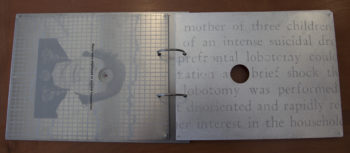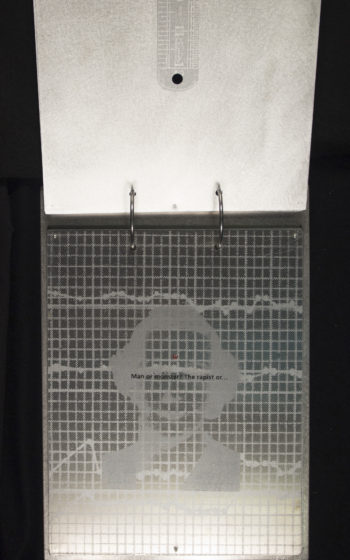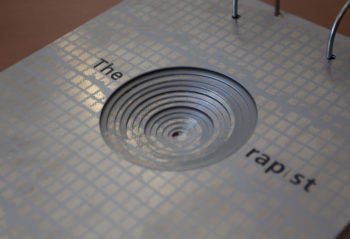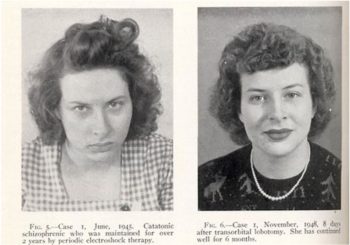
The/rapist: An Artist Book by Maureen Cummins

In 1949, a neurologist from Portugal named Egas Moniz won the Nobel Prize for developing the surgical procedure known as the leucotomy. This procedure was designed to treat mental illnesses like schizophrenia, anxiety, and depression, but often led to severe complications including personality deterioration and in some cases death. Today, most Americans have never heard of a leucotomy, but they may have heard of its close cousin, the prefrontal lobotomy. This surgery was modified and popularized in America by the physician Walter Freeman, who performed it on over 3500 patients in the United States, over two thirds of whom were women.

A Sculptural Artist Book About Psychosurgery
Artist Maureen Cummins has put together a new, highly researched artist book titled The/rapist (2017) in which she explores the gendered history of psychosurgery. To create the book, she spent time in the archives of George Washington University, where Freeman’s records and tools are kept. The book is in the shape of a medical chart and is made entirely of aluminum to replicate the cold sterility of the hospital environment and Freeman’s surgical tools. The book is one of a number of pieces Cummins has created about gender and psychiatric disorders, which include Anatomy of Insanity (2008) and Crazy Quilt (1999).

Exploring the Gendered Politics of the Lobotomy
In the 1940s and 50s when Freeman was performing lobotomies, almost all psychiatric professionals were men, and they wielded a huge amount of control over their majority female psychiatric patients. Many of Freeman’s patients were depressed housewives, and they were often lobotomized without their direct consent, sometimes at the request of family members.

As the title of The/rapist suggests, Cummin’s book uses the analogy of physical rape to demonstrate how psychosurgery was used as a form of violence against women, perpetrated by powerful men in the name of progress. The hole in the center of the title, which bores down through the rest of the metal pages, breaks up the word “Therapist” into “The rapist.” Cummins uses the same technique when introducing Walter Freeman, breaking his last name into the words “free man” to highlight both his power in relation to the incarcerated women he operated on and the fact that he never faced any legal repercussions for the violence he perpetrated on them.

Freeman did not have a license in neurosurgery, so he had to enlist the help of James Watts to perform the initial surgeries for him. Later, however, Freeman made modifications to the technique so that a metal pick could be inserted into the corner of the eyesockets, rather than drilling into the skull. This modified lobotomy did not require a neurosurgeon, and Freeman began traveling around the country, demonstrating how to perform it in overcrowded psychiatric hospitals.

Using Rare Books as Source Material
Some of the photos used in Cummin’s project come from Freeman’s own 500-page monograph, Psychosurgery in the Treatment of Mental Disorders and Intractable Pain. In this book, Freeman prints many “before” and “after” photos, usually showing a patient scowling with unbrushed hair and dingy hospital clothes “before” and then smiling and wearing makeup and jewelry in the “after” photos. Washington University Medical School’s Becker Library has an original copy of the second edition of Freeman’s Psychosurgery (1942) in their rare books collection.

Further Reading
If you are interested in Freeman and lobotomies, you can read My Lobotomy by Howard Dully, a man who was lobotomized by Walter Freeman when he was a child. Kate Larson has also written an interesting account of Rosemary Kennedy, JFK’s sister and perhaps the most high-profile person to receive a lobotomy from Freeman and Watts, titled Rosemary: The Hidden Kennedy Daughter. The lobotomy Freeman performed on Rosemary left her permanently incapacitated, and was likely a motivation for JFK to pass the influential Community Mental Health Act while he was president, initiating sweeping reforms in mental health that led to large-scale institutionalization.